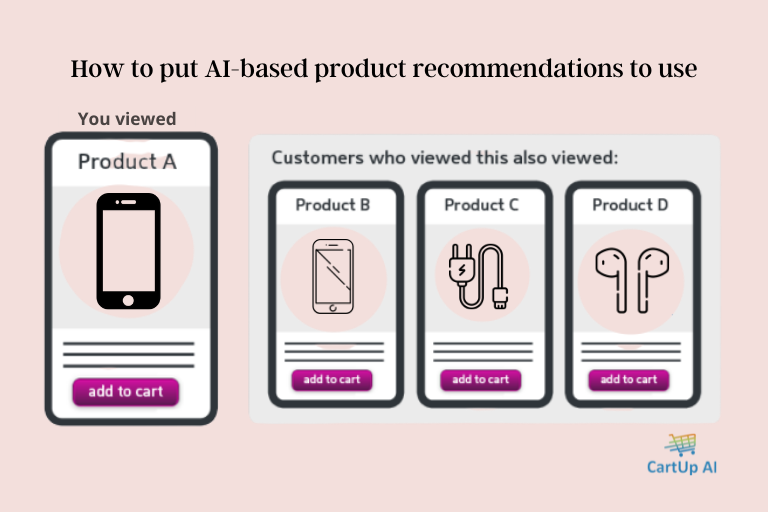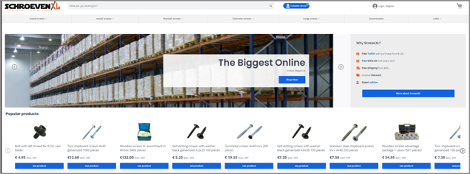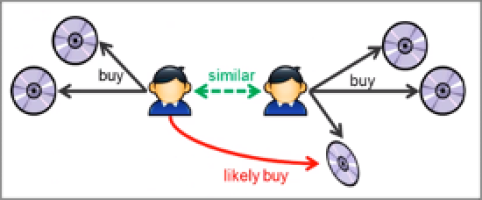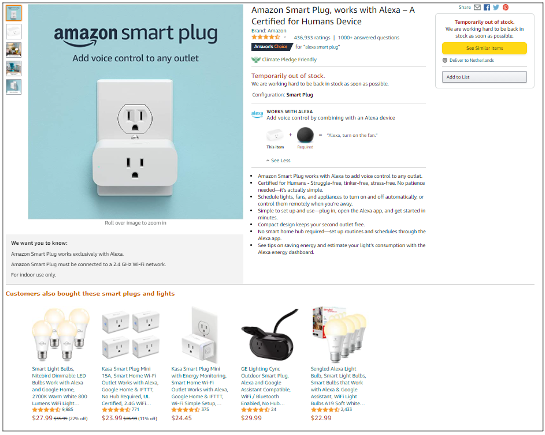Arvind Rapaka
•24 Aug 2021
How To Put AI-Based Product Recommendations To Use

Placements of recommendation widgets on the site
E-commerce sites display product recommendations across most types of sites pages, the home page, category pages, product detail pages, and shopping cart pages. Each page type offers different opportunities to seduce your visitor.
For example, on the home page, if that’s where your visitor lands, you’d want to seduce this visitor to buy what’s trending, or to buy something that fits with what he’s bought before, or a product that relates to what he’s been browsing for before.
On a product detail page, however, you’d want to recommend products that are a suitable alternative for the product he’s currently considering. Also, presenting proper accessories to the product on display offer good opportunities to increase the number of items in your customer’s basket.
So, there are specific algorithms that fit well on specific locations on your site. This section runs through the various pages and introduces algorithms that fit well on that location.
Request a free demo
Custom demos typically last for 30 minutes.
The diagram below summarises the widgets that are best suited to each type of page:

Recommendations on the home page
The home page is like the shop window to your site. Having personalized recommendations that match visitors’ intent is critical in conversion and provides a great shopping experience. Some might know what they are looking for, and others are just browsing, and your product recommendations need to cater to both.
Trending items
Works well on a home page for new as well as returning visitors. Products are recommended that are most sold recently. These are based on purchases made by all visitors. The benefits are:
- Creates awareness of new fashionable products, product features (materials, colours, etc.), and ‘hot’ product releases.
- Increases average basket size as addressing latent needs results in more items per session.

Likely next buy
The likely next buy algorithm takes all historical customers’ buying patterns into account. So, when a specific returning customer visits the site, the algorithm first determines the products that this visitor has bought previously. Then it looks at all other customers to determine which customers have also made the same purchases. Finally, it then determines the most likely additional purchases that customers have made, on top of the initial purchases, also made by the current visitor. In other words, if you have bought two CDs previously, and I have bought the same two CDs, and I subsequently bought the third CD, then you’d also be likely to want to buy that 3rd CD. So, that 3rd CD is then the likely next buy for you.

This highly personalized algorithm works great on the home page because it’s like the shop clerk that says to the customer that enters the store: “Hey Mr Jones, welcome back! I know which clothes you have in your closet, that is why I think these additional clothes would go great with what you have. I know, because all our other customers have liked it as well.”
Based on your browsing history
This personalized e-commerce recommendation algorithm recommends products based on previously viewed and bought products. From these products, the categories, brands, or other product attributes are identified. Products are then recommended that relate best to these attributes. This greatly improves the customer experience because the search time and effort to discover products associated with the visitor’s intent is minimized. It increases the number of products in the basket because it will trigger conversions on latent needs.
It fits well on the homepage because products are recommended based on interests the visitor has portrayed before. It is specifically relevant with a large highly varied assortment.
Table stakes recommendations
Of course, when a visitor lands on the home page, it’s a must to assist him in picking up his previous session, by offering an overview of his recent views. Also, when you’re providing your visitors to keep track of the product they like, by maintaining a wish list, it’s good practice to give them easy access to that wish list. An even better practice is using the information from your visitors’ wish list to personalize your recommendations by taking into account the attributes of these products as visitor signals in the visitor profile.
Recommendations on the category page
When landing on a category page, your visitors probably know what they are looking for. A category page is basically a homepage for a subset of your assortment. All the principles applied to the home page also apply to the category page, albeit for reduced product scope. Sophisticated recommendation systems allow you to filter recommendations into specific categories.
So, the best practice here is to apply the same algorithms to the category page, as you would do to the home page, and then filter the recommendations to that specific category.
Recommendations on the product page
The most crucial page of the site is the product page, as this is the gateway to the actual conversion. Recommendations of products that present perfect complementary selection to the current product, can lead to additional sales, increasing the number of products in the basket. Recommendations that present the right alternatives to the current product either reinforces the customer’s initial choice or give the customer options to chose from. If these complementary selections and alternatives are also matching the customer’s intent, the probability of conversion is maximized.
Frequently bought together
When a power drill is often accompanied by a specific set of drills, bought together in the same session, and when this combination is bought by a high number of customers, it makes sense to suggest this combination to other customers as well. So, on the product page of that power drill, the best practice is to recommend additional products, such as that set of drills, alongside the power drill. So, the approach to presenting complementary selections on the product page, that go well with that product, is to identify which products are often bought together.
These products can then be recommended in a bundle, like the top of the image below, or in a carousel of multiple recommendations. For example, a carousel can be applied to give the customer the choice from a set of complementary batteries to an electronics gadget. The carousel is visualized at the bottom of the image below.

Frequently viewed together / people also viewed
Proper alternatives to the product presented on the PDP can be identified in several different ways. Viewed also viewed is the first way to do this. When a visitor views products within the same session, it suggests that these products are alternatives to each other. So, when the viewing behaviour of all visitors is analyzed, and combinations of products emerge that are often viewed together, these combinations are proper candidates for alternatives.

Product attribute-based recommendations (content-based recommendations)
Products that are alternatives to each other often share the same brand, specifications, product names, or other attributes. So matching products together based on these attributes is a powerful way to identify alternatives. This is specifically true for categories with products that have a lot of specifications, such as consumer electronics, or power tools.
Cutting edge Natural Language Processing and Natural Language Understanding algorithms can match products based on these attributes. The more the algorithms are trained for a specific category, the better they perform. That is why even Amazon has a hard time applying this approach because of the variety of different categories on sale on its site.
These AI-based recommendations are also sometimes referred to as content-based product recommendations, as it matches combinations of products, based on the content associated with these products.
Category based recommendations
A third approach to recommending alternatives is to simply recommend a product from the same category. While this approach is rougher and simpler than the previous two, it may work very well if categories are defined narrow enough. In the example below, smart plugs and lights are the categories from which alternatives to the selected smart plug are presented.

Recommendations on the cart page
When you check out at an outlet of a savvy retailer, you will find baskets or even a full maze of products before you reach the counter to pay for what you’ve bought. Customers, while waiting in line and while checking out at that physical store can be easily seduced to throw a couple of cash grabs into their basket. How can we achieve the same result in e-commerce?
How can you reproduce a similar temptation in an e-commerce store?

Cash grab recommendations
To achieve this, of course, you must place recommendations on your cart page. To achieve the cash grabs temptation, you may choose to present specific categories of cheap seductive products, such as cables, batteries, or other accessories. From these categories, the cheap trending items can be recommended for maximum conversion probability.
Accessories on the cart page
It becomes even more powerful when you base the recommendation on the products that are already in the basket. So, when you recommend accessories that are cheap enough to trigger an impulse buy and are a perfect match to what you’re buying already, your conversion chances are highest. To achieve this, you can apply a “frequently bought together” algorithm and filter the results to specific categories and or to a maximum price limit. That price limit is dependent on the assortment of the shop.
Add to cart button
Now, you must be careful to not distract your visitor from his journey to the payment gateway. So, your visitor should not be driven backwards in the buying journey. So, clicking on the recommendation on the cart page should not result in opening a new product detail page. Instead, your recommendations on the cart page should always be accompanied by an add-to-cart button. For fashion, this brings the additional complication that the add-to-cart button should include an option to select a size variant.
Conclusion
To get the results from your e-commerce product recommendations, you must get a couple of things right.
- Select and implement a true AI-based e-commerce personalization solution
- Deploy the right product recommendations at the right place.
CartUp AI will provide you with an easy-to-use fit-for-purpose, a high-performing toolbox of recommendations algorithms that enable hyper-personalization of product recommendations. This will turn shoppers into buyers. Guaranteed.
 CartUp AI
CartUp AI Accelerate your transition to true personalization using Generative AI using CartUp AI.
© 2024 CartUp AI, Inc. All rights reserved.